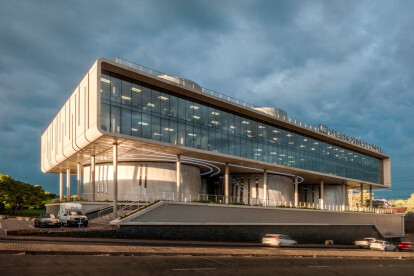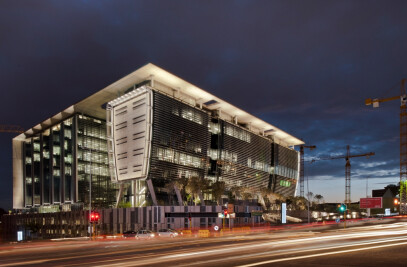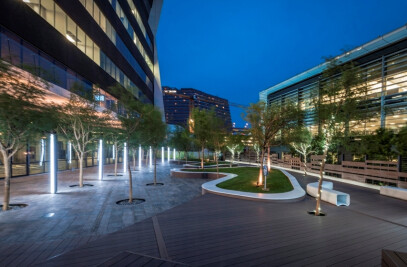BASE STRUCTURE
Combination of Brickwork and Concrete walls clad in African Blue Slate Riven Walling with a contrasting ‘band’ of louvres in silver to break up the scale of the basement’s bulk. WRAP
AROUND CONCRETE APRONS- provide a defined edge to the basement base structure and start of the lighter forms, and divides Riven Walling from louvre forms. GROUND FLOOR PODIUM FLOOR FINISHES
Combination of polished Concrete walkways with saw-cut pattern and inlay of slate tiles at entrances in a formation similar to the riven walling on the basement façade Infill landscaping – to be indigenous, water-wise, low maintenance, with tall grass-like planting on the perimeter to soften the edge of the building and hide the balustrade. Roof landscaping to match the ground floor podium with a combination of polished concrete walkways and indigenous, waterwise landscaping. CONCRETE BOX FORM
the concrete box form encompasses two levels of offices and is unique because of its curved gables with striking slot windows making vertical ‘slashes’ in the form. The dark glass in the slot windows again used to emphasise the matt texture of the concrete box. The main glazed facades single glazed in a slightly reflective glass, (in an effort to move away from very black glass which complies with heating, cooling, glare requirements) CONES
Steel columns clad in a layer of galvanized sheeting which forms the weather line and then final cladding to be silver Caiman by Arcelor Mittal on a special sub structure made up of ‘omega Rails’, which form a gap between cladding layers for ventilation. Steel structure workshopped between str eng, 3d model of steel structure submitted by the steel sub-contractor, overlaid onto the Revit model for co-ordination and then approved (process of designing structure and approving shopdrawings cut short to ensure information could reach site faster)- challenging to co-ordinate this process between steel, cladding and glazing subcontractors, with each junction being unique because of the unusual forms. Glazing in these cone forms highly
reflective for the narrow strip windows and dark at entrance shopfronts to accentuate the folding forms of the cones. The roof cones have a lightweight soft roof on steel structure. The internal walls of the cones are clad in skimmed and painted dry-walling, in sculptural forms which appear to be folding and pull away from the structure in places to make dramatic envelopes of space. The windows are punctures in these walls, with slanted sills and tapered reveals, almost church-like? LIGHTING
The cones structures have a band of lighting at their base and head to give the impression that the forms are floating, and at night will appear to be divorced from the concrete form below and above. The ground floor podium will have winding strips of cold cathode lighting in the soffit which will lead the user to entrance doors and enhance the playful forms of the cone structures. The reception cone is to have striking barrisol light inserts in the ceiling bulkhead to give the space an even ‘spaceship-like’ glow.
General description
A landmark ‘A’ grade office complex currently under construction by Tiber Bonvec in Corlett Drive overlooking the M1 freeway in Johannesburg features a two-storey concrete podium structure with curved gable ends.
The structure is designed to simulate the look of a jewel box supported on three glittering conical forms covered in reflective Caiman metal cladding.
With high visibility for passing motorists on the elevated freeway, the unique structure could act as a “highway access totem”. “The construction of the curved gable ends of the podium, the off shutter slab and the off shutter slab recesses, all with high quality seamless finishes, required careful application of skills,” says Mario Ferreira, project manager at Tiber Bonvec Construction. “The challenge lies in constructing an off shutter slab and off shutter recesses without damaging the soffit while other work is proceeding above that level. The curve itself up to the joint, along with the recesses for strip windows as well as the gable ends, forms part of the entire cast in order to achieve a seamless finish. This type of work, including the building of the slit recesses, can double the amount of time taken to complete that aspect of the job. ”
He said the lower slab of the podium was cast in two parts with the curved gable ends being part of the slab. “Special steel shutters were fabricated by PERI for the construction of the curved gables. The shutters were split into 2.470m lengths and comprise an external shutter with a floating internal shutter. We used a crane to install the shutters for the construction of the lower curved gable ends, and then removed the shutters, reversed them and fixed them into place for the construction of the upper curved gable ends.
“Our methodology was to fix the rebar and cast the majority of the podium lower flat section initially and then tie in the curved sections. Once those were cast, we built the vertical walls of the podium as separate sections before tying the upper curved gable ends into the walls and starting on the upper slab of the podium.” Ferreira said a total of 2 000 m³ of concrete was required for the entire podium. In addition, 600 m³ of concrete was used for the first floor slab, and the same amount for the second floor slab. ‘Our initial intention was to erect a batch plant adjoining the site but since there is a council park directly opposite we opted to have Readymix deliver concrete on demand.
He said the construction of the cones was also an unusual aspect of the build, undertaken by fixing vertical steel vertical posts between the ground floor and the first floor. Galvanised steel material and waterproof membrane were fixed to the steel frames prior to the cladding being applied on the exterior.
The building comprises: • three levels of basement parking • ground floor with a landscaped podium at highway level and three pods which are used for reception and waiting area, separate training room and a separate office • upper ground with a mezzanine in one of the pods • first floor –offices • Second floor - offices • Roof top - entertainment area with executive dining.
Site establishment took place on 25 January 2012 once bulk earthworks and lateral support of the excavation had been completed. Bulk earthworks were undertaken by Diesel Power and Stefanutti Stocks completed the lateral support as sub contractors to Diesel Power. “There was a lot of rock on the site and this forced us to change our methodology for the preparation of our bases,” says Ferreira. “For between 60 and 70% of our bases we had to dowel into the rock to commence with the columns. We sub contracted Gauteng Piling to undertake the drilling into the rock between 2.8m and 3.5m deep. We then doweled and grouted using W32 and Y40s. Rock removal was a major challenge because of the hardness of the material. Overall, this unexpected geological issue added about two weeks to site preparation.”
He said the high water table has resulted in a large volume of water flowing into the site and additional sumps have been constructed. A pumping system designed by JKJ Pumps is being installed to manage the water flow. DESIGN CONCEPT
“The concept of the building is derived from a number of sources including the location and context, the choice of materials and the accommodation requirements. The prime site offers an opportunity to generate a jewel box of crafted materials including glass and the Caiman cladding for the cones,” says Paragon Architect’s Carla Soudien. “Computer software was used to generate a taut collection of forms that challenges traditional expressions of materials like concrete and glass. Extensive planting on the podium also softens the structure for the inhabitants. “
Soudien says the design is based on a glazed box which appears to float, supported by the three conical forms. The product on the cones is Caiman cladding by ArcelorMittal. Product selection was driven by (an?) aesthetic requirement as well as being competitively priced. Caiman cladding provides a glimmering effect that is achieved with changing light qualities. ( Additionally it could hold the required form while other materials could not)
“On the north and south elevations a reflective laminated Solarshield S30 has been specified. On the east and west elevations a tinted Eclipse Grey Advantage glass has been specified. Ivan Lin assisted with glass specification vis à vis sound insulation, advising that laminated glass could achieve the insulation performance for the allocated budget.” Total quantities used in the construction of the building comprise concrete - 6 400 m³, re bar - 687 tons and stock bricks - 392 000.
A total of 250 people, including sub contractors, were employed on the construction site at the height of the build.

































